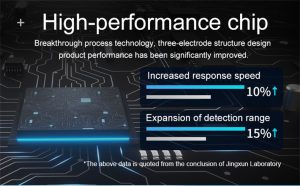Gas sensing technology has made significant advancements in recent years, revolutionizing safety and quality control measures across various industries. As the demand for improved safety and higher quality products continues to grow, the future of gas sensing technology holds immense promise. This article explores the potential of gas sensing technology in enhancing safety and quality control processes, paving the way for a safer and more efficient future.
Advanced Gas Sensing Techniques:
Future gas sensing technologies are expected to incorporate advanced techniques that improve accuracy, sensitivity, and selectivity. One such technique is the use of nanomaterials, which can enhance the surface area and reactivity of gas sensors. Nanosensors offer higher sensitivity, faster response times, and the ability to detect lower concentrations of gases. Additionally, advancements in machine learning and artificial intelligence will enable gas sensors to learn and adapt, improving their capability to identify and differentiate between different gas types.
Real-Time Monitoring and Alerts:
The future of gas sensing technology lies in real-time monitoring and instant alerts. Traditional gas detection systems often rely on periodic sampling and manual analysis. However, with the integration of wireless connectivity and IoT (Internet of Things), gas sensors can transmit data in real-time, allowing for instantaneous monitoring and analysis. This enables proactive measures to be taken promptly, preventing potential accidents or product quality issues.
Integration with Smart Systems:
Gas sensors of the future will be seamlessly integrated into smart systems, creating an interconnected environment that enhances safety and quality control. For example, in industrial settings, gas sensors can communicate with automation systems to trigger alarms, shut down processes, or adjust ventilation systems when hazardous gases are detected. Similarly, in the food industry, gas sensors can be integrated into packaging materials to monitor food quality, ensuring freshness and minimizing spoilage.
Miniaturization and Wearable Gas Sensors:
Advancements in gas sensing technology will lead to smaller, more portable gas sensors that can be worn or carried by individuals. This opens up new possibilities for personal safety monitoring in hazardous environments. Wearable gas sensors can continuously monitor the air quality around an individual, alerting them if any harmful gases are detected. These sensors can find applications in industries such as mining, construction, and chemical handling, where workers are exposed to potential gas hazards.
Gas Sensor Arrays:
Future gas sensing technology will utilize sensor arrays, which consist of multiple gas sensors working together. Sensor arrays offer several advantages, including enhanced selectivity, improved accuracy, and the ability to detect complex gas mixtures. By using multiple sensors with different sensitivities, gas sensor arrays can provide comprehensive and reliable gas analysis, ensuring better safety and quality control.
Environmental Monitoring:
Gas sensing technology will play a crucial role in environmental monitoring in the future. With increasing concerns about air pollution and climate change, there is a growing need for continuous and accurate monitoring of greenhouse gases and other pollutants. Gas sensors integrated into monitoring networks and deployed across cities, industrial areas, and sensitive ecosystems will provide real-time data on pollutant levels, facilitating effective environmental management and policy formation.
Cost-Effectiveness:
As gas sensing technology continues to evolve, it is expected that the cost of gas sensors will decrease, making them more accessible to a wider range of industries and applications. This cost-effectiveness will further encourage the adoption of gas sensing technology, leading to improved safety and quality control across various sectors.
Conclusion:
The future of gas sensing technology is promising, with advancements in accuracy, real-time monitoring, integration with smart systems, miniaturization, and sensor arrays. These developments will bring significant improvements in safety and quality control measures across industries, enhancing workplace safety, product reliability, and environmental management. As research and innovation in gas sensing technology continue, we can expect a safer and more sustainable future driven by the power of advanced gas sensors.
 : +86 155 8830 2704
: +86 155 8830 2704 : jxdziot@gmail.com
: jxdziot@gmail.com
